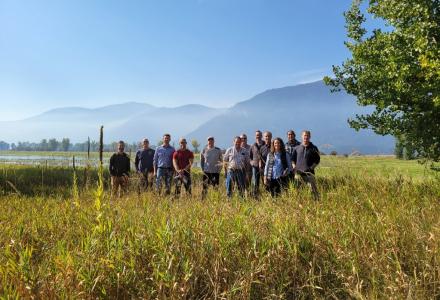
Invasive zebra and quagga mussels have made their way westward since being detected in the Great Lakes in 1988, recently encroaching into Montana waterways. The economic and ecological impact has water managers in the sensitive and sizable Columbia River basin – located in the Pacific Northwest – increasingly worried about keeping these hard-shelled bivalves out.
The Okanagan Basin Water Board (OBWB) is quite concerned, said Executive Director and Dr. Anna Warwick Sears, also Canadian Section member of the IJC’s International Osoyoos Lake Board of Control.
Sears wants to see stronger efforts by the US and Canada, and all western states and provinces to make sure boaters don’t accidentally spread the destructive creatures, which can ride along on boats and other watercraft and survive for up to a month in wet carpet or bilge water in their microscopic larval stage. While the province encourages boaters to follow the “clean, drain and dry” procedures for their boats and equipment, the ability of these larval mussels to survive even in wet carpeting for up to two weeks limits how effective that process is for mussel species.

According to James Littley, OBWB operations and grants manager, boats are the greatest vector of concern when it comes to the zebra mussel. British Columbia has been running a pilot inspection program for the past two years to check boats and either quarantine or decontaminate them if the risk factors are great enough. In the summer of 2016, their permanent and roving inspection stations found 17 boats being towed that had confirmed mussels onboard. While that’s a pretty small number compared to the thousands of boats that come to the province from Alberta and the US states each year, it only takes one to introduce mussels into a lake.
If mussels were to invade waterways in the Okanagan basin, it would be a massive blow to the economy. Sears said towns and communities in the basin have a recreational boating and tourism industry, and if mussels were discovered in one waterway, such as Osoyoos Lake, it may be quarantined, with people barred from bringing boats in or out. Power plants and water intakes in areas where the mussels have already invaded spend millions of dollars annually to scrape the mussels off of infrastructure, as they notoriously will attach to and clog pipes, turbines, engines and any other equipment. The Okanagan basin is in the midst of restoring its salmon fishery – a vital part of the First Nations and tribal cultures in the region – and the mussels’ impact on the food web could harm those efforts too.
There aren’t any practical methods of eliminating mussels in open waters at this point – if they’re in a lake or other water body, they can infest it, as well as any areas upstream or downstream, virtually unchallenged. Pesticides are used in closed systems, though experiments are underway to try and use them in Minnesota lakes and in Lake Winnipeg using potash to see how safe and effective they could be.

Besides British Columbia’s inspections program, which now includes five permanent locations and three mobile crews, the Canada Border Services Agency (CBSA) has started training people to ask the appropriate questions and carry out basic inspections on boats. Unfortunately, Littley said, there aren’t universal enforcement standards within the CBSA, so while the Okanagan station may do well on its inspections other stations may not be as effective due to time constraints.
Littley said that the US federal government has matched money with Pacific Northwest states to improve inspections in the Columbia River basin through the US Army Corps of Engineers. He believes it would be helpful if the Canadian government did something similar with the governments of Saskatchewan, Alberta and British Columbia, which are believed to be still free of invasive mussels.
The OBWB has launched its own effort to raise awareness around the invasive mussels, the expected impacts on the Okanagan, and measures to protect area waters at DontMoveAMussel.ca. The website includes information about the mussels, the danger they present to native ecosystems, ways to prevent their spread and news updates regarding mussels for the Okanagan basin.
The waterways in the basin are already contending with other invasive species. Notably, the Asian clam has been found in US portions of the basin, though not yet reported in the Canadian portions of the basin. Unlike zebra mussels, they do not have as severe an impact on human infrastructure – they cause ecosystem problems by impacting the native food web. Nevertheless, the prolific and dangerous zebra and quagga mussels don’t need to provide any help in ravaging the local ecosystem.

Kevin Bunch is a writer-communications specialist at the IJC’s US Section office in Washington, D.C.




